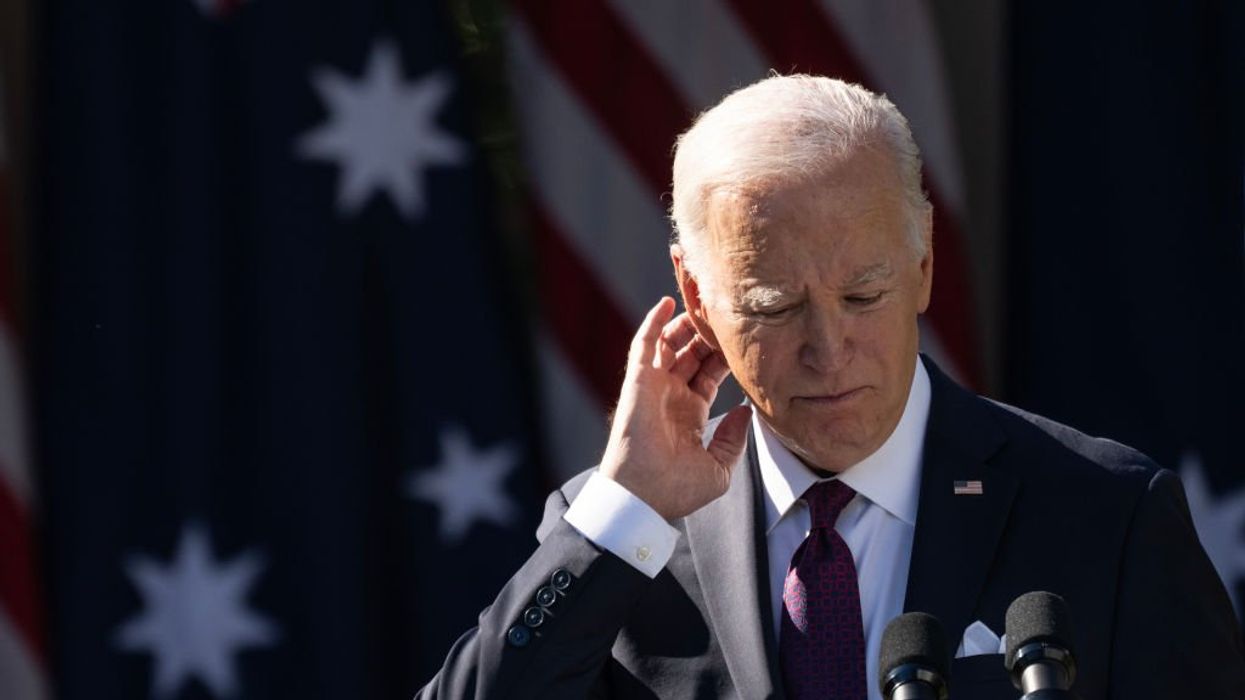
Drew Angerer/Getty Images

New data shows that corporations under Joe Biden’s administration have become richer, while families have burned through their savings.
Americans are a little more than a year away from the 2024 presidential election, and surveys show that the economy will likely be one of voters’ top concerns.
That could prove to be disastrous for Joe Biden. Several polls now suggest that voters have a low opinion of the president’s economic performance. One recent NBC poll, for example, found that 59% of registered voters said they disapprove of Biden’s handing of the economy.
Though several reasons could explain voters’ economic discontent, the latest data about the U.S. money supply, corporate wealth, and household savings tells the whole, sad story.
Under the Biden administration, the government has continued to pump unprecedented amounts of money into the economy, but those policies appear to have disproportionately benefited large corporations, which are hoarding trillions in cash and investments while American families burn through their savings.
Data compiled by Investor’s Business Daily shows that businesses in the S&P 500 are holding $2.6 trillion in cash, a 20% increase compared to cash held by the same group at the end of 2019. Apple alone has about $167 billion in investments and savings.
Much of that cash was amassed by large businesses in 2020, as the Democrat-led Congress and President Trump agreed to print trillions in new dollars to fund lockdown-related relief packages and costly stimulus policies.
Since Biden entered the White House in January 2021, large corporations have continued to remain flush with cash. In fact, cash holdings for big businesses are about the same today as they were at the end of 2020, which means they have managed to thrive despite the recent surge in inflation. Meanwhile, working-class, middle-income, and lower-income families have experienced real losses.
American households experienced across-the-board increases in their checking and savings balances in 2020, according to Federal Reserve data. At the start of 2022, real household savings for middle-income Americans was 113% of what those balances had been in March 2020, when the most significant coronavirus lockdowns began.
Now, on its face, that might look like a positive trend. But the reason corporations and families experienced huge increases in cash holdings wasn’t due to economic growth — remember, much of the economy remained closed in 2020 and 2021. The increase in cash was directly related to sharp increases in the money supply, which grew by more than $3.37 trillion from March 2020 to January 2021, by far the most rapid increase in money supply in U.S. history.
Rather than decrease the money supply or even hold supply levels flat, the Biden administration and congressional Democrats opted to keep spending levels high, adding another $2.19 trillion to the money supply in 2021 alone. Making matters worse, the Federal Reserve encouraged the government’s spending addiction and kept interest rates low, despite troubling signs.
Democrats’ reckless spending — coupled with the war in Ukraine, Biden’s attacks on affordable energy, and low interest rates — fueled an inflation crisis that has been unlike anything Americans have experienced in four decades.
As a result, a family purchasing $200 worth of groceries in 2020 would spend more than $238 today for the same products, based on the federal government’s consumer price index calculations, which likely undercount inflation.
In a frantic effort to stop prices from skyrocketing further, the Federal Reserve increased interest rates at breakneck speed in 2022 and 2023. Despite this dramatic reversal in monetary policy, prices have continued to go up.
The Biden administration claims its policies have provided relief to the middle and working classes, but the evidence suggests that its addiction to debt and government spending has disproportionately hurt households, especially middle-income families.
Although large corporations have maintained or even increased their high levels of cash and big investments, even when you factor in the cost of inflation, most households have less cash on hand, in real terms, than they did when the pandemic started.
The most recent data from the Federal Reserve shows that in September 2023, real cash savings for the bottom 40% of earners was 92.4% of what it had been in March 2020. Middle-income earners had 98.6% of their March 2020 balances. And all indications are that these figures are likely to get substantially worse over the next year.
Only the top 20% of earners have maintained the savings they gained in 2020 and 2021, but their cash has been rapidly depleting and is now on track to dip below March 2020 savings early in 2024.
These figures are supported by other data showing that households are struggling to pay their bills. For example, a U.S. Census Bureau survey ending in early August found that 27.27 million Americans say they “sometimes” or “often” do not have enough to eat, an increase of 3.52 million since January 2021.
Perhaps the one bright spot for families in the Biden era has been that the value of homes is still well above 2020 prices, although prices have declined by more than $50,000 since the end of 2022.
But even this positive news is limited to people who already owned homes in 2020 or bought in at the start of 2021. Families looking for homes for the first time today are seeing some of the costliest mortgages in decades, due to the combination of high prices and relatively high interest rates.
Many big corporations and some wealthy earners are still better off today than they were at the start of 2021, but everyone else is worse off, and some groups are barely getting by.
This is what “Bidenomics” really looks like.
Justin Haskins